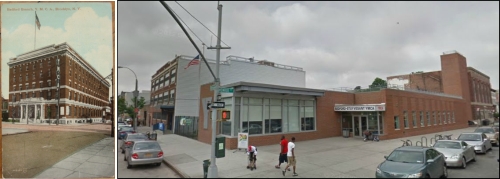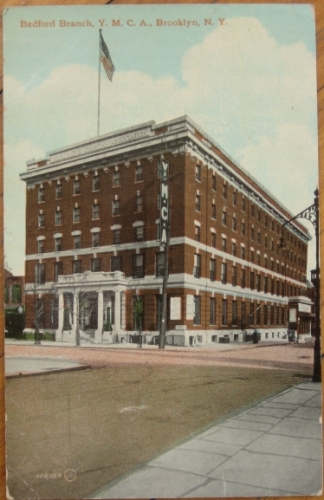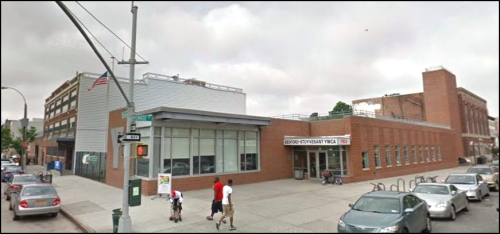Past and Present: The Bedford YMCA
A look at Brooklyn, then and now. The Young Men’s Christian Association, now called the Y.M.C.A, began in London in 1844, as a refuge for young men new to the city. London could be an overwhelming, lonely and godless place to a country lad or a young sailor, and the founders of the organization wanted…

A look at Brooklyn, then and now.
The Young Men’s Christian Association, now called the Y.M.C.A, began in London in 1844, as a refuge for young men new to the city. London could be an overwhelming, lonely and godless place to a country lad or a young sailor, and the founders of the organization wanted to establish a place where they could come for Bible study, prayer and friendship. The idea proved so successful that the first American YMCA was established in Boston in 1851 by a retired sea captain and missionary named Thomas Sullivan. Soon there were branches in American cities across the country.
The first YMCA in Brooklyn was established in 1853. It was a purely evangelical association, conducting street preaching, handing out Bibles and tracts, and conducting Bible studies and lectures. They met in churches and meeting halls in Downtown Brooklyn. When the Civil War broke out, the Brooklyn YMCA was one of the many Y’s to send volunteers to the front, to distribute Bibles and minister to the troops. Walt Whitman was one of these volunteers.
After the war, the organization began to concentrate on more than spiritual needs. The first YMCA building was built in 1866, on Fulton Street near Gallatin Place, just down the street from where Macy’s is today. That building had a lecture hall and recreation rooms. They outgrew the space by 1885, and a larger Y was built further down Fulton Street, between Livingston and Bond. By this time the Y had begun to emphasize the physical fitness programs that are its hallmark today, based on the athletic programs of the German Turn Verein clubs. Many organized sports and games came out of the YMCA organization, including volleyball, and the new game of basketball was immediately embraced by Y teams across the country.
The Y also furthered the sport of swimming, with innovations in pool filtration, enabling large indoor pools to be built in their facilities. This would be a mainstay of most YMCA’s, with a national goal of teaching every child to swim. By the beginning of the 20th century, the Y was still evangelical, but their zeal had evolved to encompass the whole individual; body, mind and soul. They offered low cost housing to young men, and they began offering classes, teaching reading, business and trade skills. The arts were also fostered, with concerts and other programs.
As Brooklyn grew, so too did the number of branches. Bedford was one of the fastest growing parts of Brooklyn in the late 19th century, and they wanted a YMCA. The Bedford branch was established in 1888, in a building at 420 Gates Avenue. That building had a lecture hall, meeting rooms, and recreation rooms. It soon proved to be too small. By 1890, meetings were being held by some of the neighborhood’s wealthiest and most influential men, who pledged support for the building of a much larger and expanded YMCA building. It took a while, but in 1901, ground was broken on a large plot located at the corner of Bedford Avenue and Madison Street.
The new building was the design of the firm of Jackson and Rosencrans, of Manhattan. It was sturdily constructed with the steel underpinnings now being used in the new skyscrapers. When completed, in 1905, it was the second largest Y in Brooklyn, second only to the main branch on Hanson Place. It had state of the art facilities: gymnasium, swimming pool, locker and shower facilities, classrooms, auditorium and the traditional YMCA rooms for rent. They soon established award winning teams, especially in swimming, with the swim team of 1912 winning a national championship. They also had league winning teams in gymnastics, track, and basketball.
The building was host to lectures, meetings and other community activities, both of a religious and secular nature. In 1919, a new wing was added to the building to accommodate their trade school activities, which included training in auto mechanics, aviation, and other new technologies of the day. These programs would continue until the 1970s.
However, as the years went by, in the mid-20th century, the Y, like many other institutions in Bedford Stuyvesant, saw a decline, both in the quality of services and in community interest. All of the adult classes were discontinued, due to a decline in membership. The building underwent a renovation to make it usable as an alcoholic treatment center run by the city’s Health and Hospitals Corporation, in conjunction with another program called Model Cities. In 1991, the Bedford YMCA revamped its children’s programs and began offering new youth programs. Renovations were made in the building, the pool was repaired and put into use again after a long absence, and new directors began bringing the institution back. New gym equipment was bought, and the community began using the facility again.
But by 2007, the powers that be determined that the old building was no longer adequate for the new activities of the Y. It was torn down, and a new building now replaces it. This new 41,000 square foot facility is now one of the most popular YMCA branches in Brooklyn, and is often filled to capacity. No longer a sleepy outpost; a new emphasis on physical fitness for both children and adults, along with its other programs, keeps this place humming. With 2,000 members at its new opening, the Bedford Y now has over 8,000 members, and in a few years, will probably need to expand again. GMAP







What's Your Take? Leave a Comment